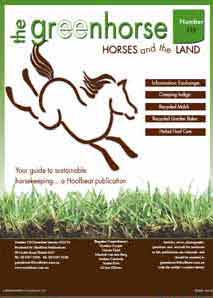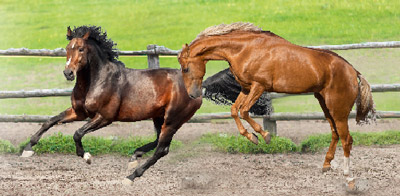The Green Horse section provides practical information on managing environmentally sustainable horse properties, readers stories and tips, as well as advice and articles from equestrian experts in their fields.
AUGUST SEPT 20
Vol 42 No 2
In this issue of The Green Horse you will find the following articles:
PIRATES IN THE PADDOCK
by Rhiannon Brown - Envirapest
Regrettably, weeds are one of those aspect of life that rarely seems to change. The weed population has reliably continued to ‘pop up’ in paddocks all around the country, despite the pandemic that is holding the world to ransome.
THE HIDDEN DANGERS ON THE PADDOCK by Elizabeth Tollarzo
Horses love to run, play, buck and then run again and we often, through lack of risk assessment or management practices, place them in areas that are fraught with dangers.
DEEDS,STEEDS and WEEDS
WAR ON FIRE ANTS and PRICKLY SITUATIONS SORTED ( Prickly pear and horses).
GOING SOLAR ON THE HORSE PROPERTY
Maintenance and Repairs
Part 3
Following on from the last three articles in this series, the next step looks at costs, finding a supplier, maintenance required throughout the life-cycle of the solar panels, and available feed-in-tariffs.
HORSES AS ECOSYSTEM ENGINEERS
by Kit Prendergast
Certain animals perform ‘engineering’ roles. Such animals are known as ‘ecosystem engineers’, as through their activities they can physically modify a habitat in which they live or frequent, by creating, maintaining, modifying, or even destroying it.
GROWING HERBS FOR YOUR HORSE
by Wendy Elks
Herbs, some of which are well-known to horse owners who like to use natural remedies, are easy to grow.
NOW IS THE TIME TO CHECK YOUR IRRIGATION SYSTEM
by David Ferris, WA Reticulation Supplies
Spring is a favourite time of year for many and while it’s an ideal time for a spring clean around the house and stables, on a property it’s also the ideal time to check your reticulation system thoroughly as it’s had a few months off sitting idle over winter.
WIN A YEAR'S SUBSCRIPTION...
share your equine property management tips and each issue one reader will win.
Send ideas to -
The Green Horse Support <greenhorse@hoofbeats.com.au>


PREVIOUS ARTICLES
Available on line
JUNE JULY 20 GOING SOLAR ON THE HORSE PROPERTY Where to put your panels Part 2
Once you have selected what solar system best suits your needs, then you need to look at how you can maximise the advantages.
APRIL MAY 20 GOING SOLAR ON THE HORSE PROPERTY Part 2
Once you have selected what solar system best suits your needs, then you need to look at how you can maximise the advantages.
FEB/MARCH 20 ANTS AWAY
by Mark Brown Envirapest
So, what can you do to deter ants from your house and your stables??
DJ19/20 KEEPING SNAKES OUT OF THE STABLE by Wendy Elks
Snakes may be protected under Wildlife regulations in Australia, and they may be great for keeping the mice and rats down, but do we want to find them in our stables near our horses and pets?
ON19 - TERMITES- common myths
by Rhiannon Brown, Envirapest
Your house and stables are looking wonderful this spring, but do you know what is happening inside the walls of your brick or timber building?
AS19 - OUCH THAT HURTS
by Catherine Bird for Country Park Saddlery
The extent of the swelling is usually an indication of the severity of the infection or injury and the cause needs to be established before giving herbs.
JJ19 - MANAGING PASTURE
by Rhiannon Brown, Envirapest Healthy pasture means healthy horses.
A/M19 - STOP THOSE WEEDS
Property biosecurity
by Rhiannon Brown, Envirapest
Putting simple precautionary steps into place can make it tough for weeds to get a hold on your equine paradise.
|
  
  



by Elizabeth Tollarzo
Horses love to run, play, buck and then run again and we often, through lack of risk assessment or management practices, place them in areas that are fraught with dangers.
Horses may have to be one of the most ‘accident prone’ creatures on the earth! Mostly because they are an animal adapted to living in open areas, roaming the countryside and continually moving and grazing as they go – an animal that over 5,000 years ago humans domesticated and decided to have them live among us.
As a result of when placing a horse or pony into a fenced in area - and in many cases in yards and stables – to keep them safe, owners generally will pick one of the following ideas –
1. Stable or yards to keep horses more contained and controlled.
2. Use small paddocks to limit the ‘speed’ a horse can go.
3. Use large paddocks so they have more room to move.
4. Paddock individually to prevent injuries from horse ‘arguments’.
5. Paddock in groups so ‘more natural’.
6. Free-range around buildings and run of the whole property.
Any of these choices is the decision of the horse owner. Whether it was reached by what they felt was right for them and their horse; it was based on financial feasibility; how much land they actually have and what land is suitable for horses, or really, just what is the best solution for their property structure. Perhaps they don’t have a property and have to agist. In any of these situations or discussions, it comes down to whatever is a feasible option for the owner to provide the best outcome for the safety and comfort of the horse.
IN THE PADDOCK
Over the next few issues we will cover various aspects of ‘horse housing’, starting with the paddock or yard and fencing around the stable and property.
FENCING
Fencing is a major cost of having horses, and, while we all love the thought of post and rail fencing, it is necessary to look at what is reality for most of us and how we can make it safe.
Wire – any wire fencing must be well strung, meaning tightened with no sagging wire, which could loop around a leg. All wire can cut and cause injuries, the tighter the wire the less likely the injury, the thinner the wire the more likely a cut, and of course - avoid barbed wire. Cattle farms will often have barbed wire and if it can’t be avoided then the use of electric ‘stand-offs’ will lessen the possibility where the barb is unable to be replaced.
Plastic wire - with no metal wire inside - is an owner’s choice and may be safer, however it can stretch, wrap around legs and cause extensive injuries as well. With regular maintenance this fencing is easy to keep tight and easy to strain.
Use of stock wire mesh – fencing with wire mesh is a very safe and effective fence, however for horses this needs to be small mesh not ‘field mesh’ (used for sheep, dogs and often on boundaries) which can entrap hooves when a horse falls or paws at the fences. If field mesh cannot be avoided then using a stand-off electric fence or an internal electric fence would be recommended as the wire is extremely tough and will not break should a horse become entangled.
Check all twitching of wire (or attaching of wire or wood to wire) for unravelling or breakages so no sharp wire is sticking out, which a scratching horse (or your new rug) may find!
Strainer posts are a big danger, often with double diagonal wires which a horse could put a hoof or leg in-between. Even using some electrical tape to bind the wires together or covering with conveyer belt rubber as a strip from strainer post to strainer post will lessen the possibility of possible injury – especially with young stock.
Paddock shapes can be important if planning to put horses together, corners of paddocks should be rounded off so there is no distinct corner that a bossy horse could ‘trap’ another horse in. This also helps prevents injuries of horses racing into the corners and sliding to a stop, which could result in a fall or soft tissue injuries!
LOST SHOES. If you know your horse has lost a shoe in the paddock then all effort should be made to find it. A shoe, particularly one with nails attached, can cause horrific injuries or puncture wounds. If necessary, hire a metal detector if the paddock is not too large, as it might save future vet fees! .
This is the first in a series on problems in the paddock - next issue will be gates so if you have experienced any of these problems for horses then be sure to message us via facebook to share the information with other readers.
|